HI6028 Taxation Law: CGT Implications and Income Assessment T1
VerifiedAdded on 2023/03/29
|7
|1711
|433
Homework Assignment
AI Summary
This assignment solution addresses several questions related to Australian taxation law, focusing on Capital Gains Tax (CGT) implications and the assessment of income. It examines scenarios involving the sale of collectible items such as paintings, sculptures, and jewelry, determining whether CGT applies and calculating potential gains or losses. The solution also analyzes whether certain income, such as that derived from writing a book or receiving additional payments on a loan, should be considered assessable income based on relevant legislation like the Income Tax Assessment Acts of 1936 and 1997, and relevant case law. The assignment provides detailed explanations and applies taxation principles to real-life problems, offering a comprehensive understanding of the Australian income tax system.
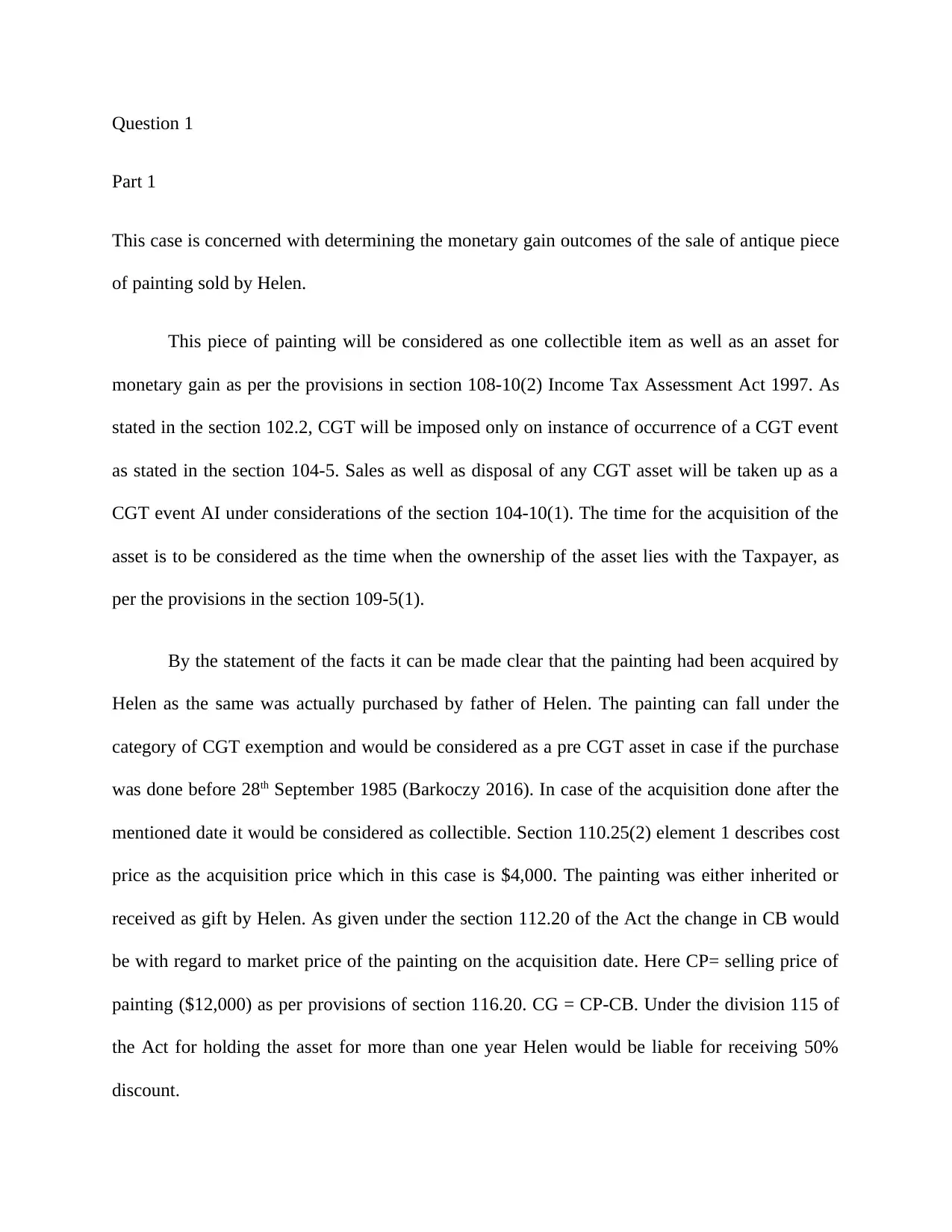
Question 1
Part 1
This case is concerned with determining the monetary gain outcomes of the sale of antique piece
of painting sold by Helen.
This piece of painting will be considered as one collectible item as well as an asset for
monetary gain as per the provisions in section 108-10(2) Income Tax Assessment Act 1997. As
stated in the section 102.2, CGT will be imposed only on instance of occurrence of a CGT event
as stated in the section 104-5. Sales as well as disposal of any CGT asset will be taken up as a
CGT event AI under considerations of the section 104-10(1). The time for the acquisition of the
asset is to be considered as the time when the ownership of the asset lies with the Taxpayer, as
per the provisions in the section 109-5(1).
By the statement of the facts it can be made clear that the painting had been acquired by
Helen as the same was actually purchased by father of Helen. The painting can fall under the
category of CGT exemption and would be considered as a pre CGT asset in case if the purchase
was done before 28th September 1985 (Barkoczy 2016). In case of the acquisition done after the
mentioned date it would be considered as collectible. Section 110.25(2) element 1 describes cost
price as the acquisition price which in this case is $4,000. The painting was either inherited or
received as gift by Helen. As given under the section 112.20 of the Act the change in CB would
be with regard to market price of the painting on the acquisition date. Here CP= selling price of
painting ($12,000) as per provisions of section 116.20. CG = CP-CB. Under the division 115 of
the Act for holding the asset for more than one year Helen would be liable for receiving 50%
discount.
Part 1
This case is concerned with determining the monetary gain outcomes of the sale of antique piece
of painting sold by Helen.
This piece of painting will be considered as one collectible item as well as an asset for
monetary gain as per the provisions in section 108-10(2) Income Tax Assessment Act 1997. As
stated in the section 102.2, CGT will be imposed only on instance of occurrence of a CGT event
as stated in the section 104-5. Sales as well as disposal of any CGT asset will be taken up as a
CGT event AI under considerations of the section 104-10(1). The time for the acquisition of the
asset is to be considered as the time when the ownership of the asset lies with the Taxpayer, as
per the provisions in the section 109-5(1).
By the statement of the facts it can be made clear that the painting had been acquired by
Helen as the same was actually purchased by father of Helen. The painting can fall under the
category of CGT exemption and would be considered as a pre CGT asset in case if the purchase
was done before 28th September 1985 (Barkoczy 2016). In case of the acquisition done after the
mentioned date it would be considered as collectible. Section 110.25(2) element 1 describes cost
price as the acquisition price which in this case is $4,000. The painting was either inherited or
received as gift by Helen. As given under the section 112.20 of the Act the change in CB would
be with regard to market price of the painting on the acquisition date. Here CP= selling price of
painting ($12,000) as per provisions of section 116.20. CG = CP-CB. Under the division 115 of
the Act for holding the asset for more than one year Helen would be liable for receiving 50%
discount.
Paraphrase This Document
Need a fresh take? Get an instant paraphrase of this document with our AI Paraphraser
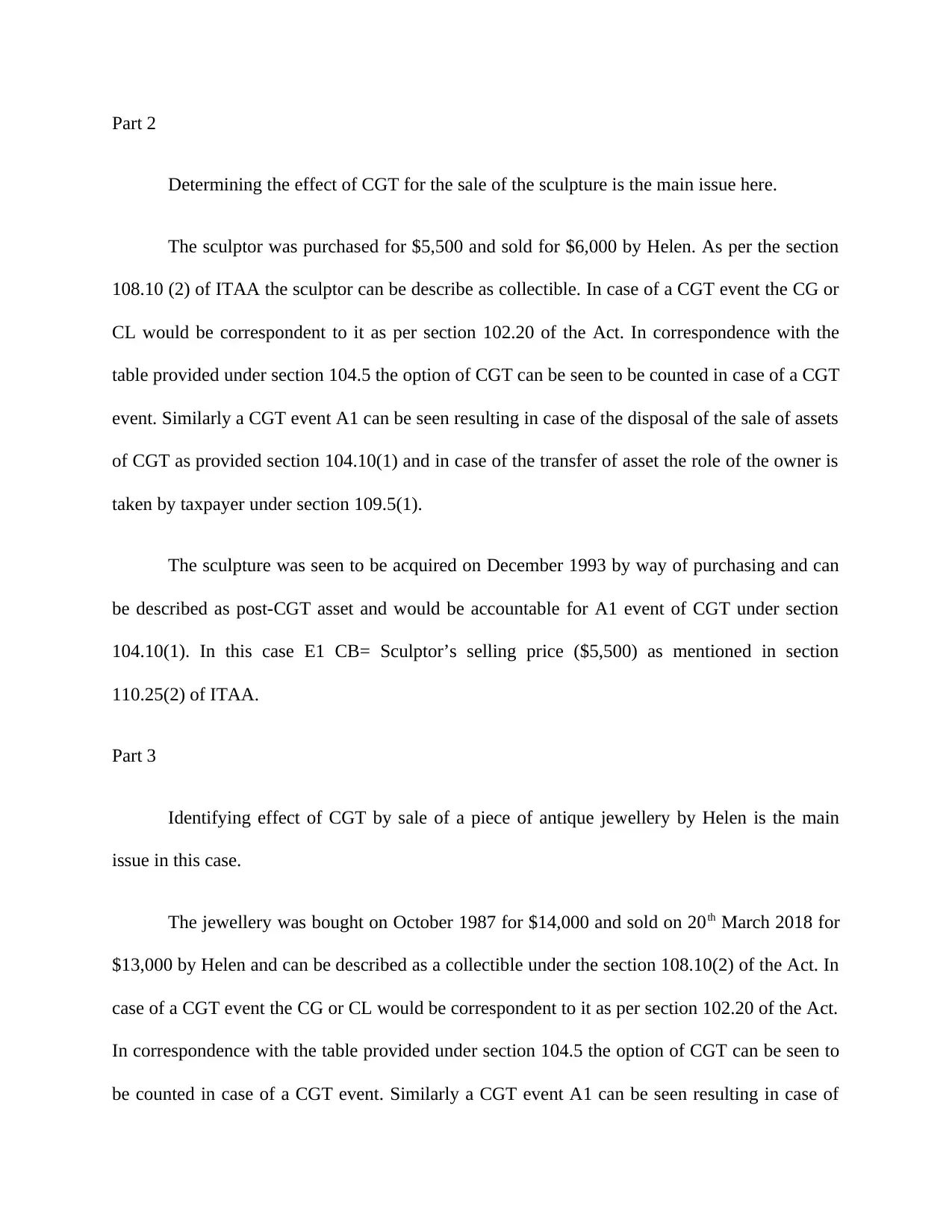
Part 2
Determining the effect of CGT for the sale of the sculpture is the main issue here.
The sculptor was purchased for $5,500 and sold for $6,000 by Helen. As per the section
108.10 (2) of ITAA the sculptor can be describe as collectible. In case of a CGT event the CG or
CL would be correspondent to it as per section 102.20 of the Act. In correspondence with the
table provided under section 104.5 the option of CGT can be seen to be counted in case of a CGT
event. Similarly a CGT event A1 can be seen resulting in case of the disposal of the sale of assets
of CGT as provided section 104.10(1) and in case of the transfer of asset the role of the owner is
taken by taxpayer under section 109.5(1).
The sculpture was seen to be acquired on December 1993 by way of purchasing and can
be described as post-CGT asset and would be accountable for A1 event of CGT under section
104.10(1). In this case E1 CB= Sculptor’s selling price ($5,500) as mentioned in section
110.25(2) of ITAA.
Part 3
Identifying effect of CGT by sale of a piece of antique jewellery by Helen is the main
issue in this case.
The jewellery was bought on October 1987 for $14,000 and sold on 20th March 2018 for
$13,000 by Helen and can be described as a collectible under the section 108.10(2) of the Act. In
case of a CGT event the CG or CL would be correspondent to it as per section 102.20 of the Act.
In correspondence with the table provided under section 104.5 the option of CGT can be seen to
be counted in case of a CGT event. Similarly a CGT event A1 can be seen resulting in case of
Determining the effect of CGT for the sale of the sculpture is the main issue here.
The sculptor was purchased for $5,500 and sold for $6,000 by Helen. As per the section
108.10 (2) of ITAA the sculptor can be describe as collectible. In case of a CGT event the CG or
CL would be correspondent to it as per section 102.20 of the Act. In correspondence with the
table provided under section 104.5 the option of CGT can be seen to be counted in case of a CGT
event. Similarly a CGT event A1 can be seen resulting in case of the disposal of the sale of assets
of CGT as provided section 104.10(1) and in case of the transfer of asset the role of the owner is
taken by taxpayer under section 109.5(1).
The sculpture was seen to be acquired on December 1993 by way of purchasing and can
be described as post-CGT asset and would be accountable for A1 event of CGT under section
104.10(1). In this case E1 CB= Sculptor’s selling price ($5,500) as mentioned in section
110.25(2) of ITAA.
Part 3
Identifying effect of CGT by sale of a piece of antique jewellery by Helen is the main
issue in this case.
The jewellery was bought on October 1987 for $14,000 and sold on 20th March 2018 for
$13,000 by Helen and can be described as a collectible under the section 108.10(2) of the Act. In
case of a CGT event the CG or CL would be correspondent to it as per section 102.20 of the Act.
In correspondence with the table provided under section 104.5 the option of CGT can be seen to
be counted in case of a CGT event. Similarly a CGT event A1 can be seen resulting in case of
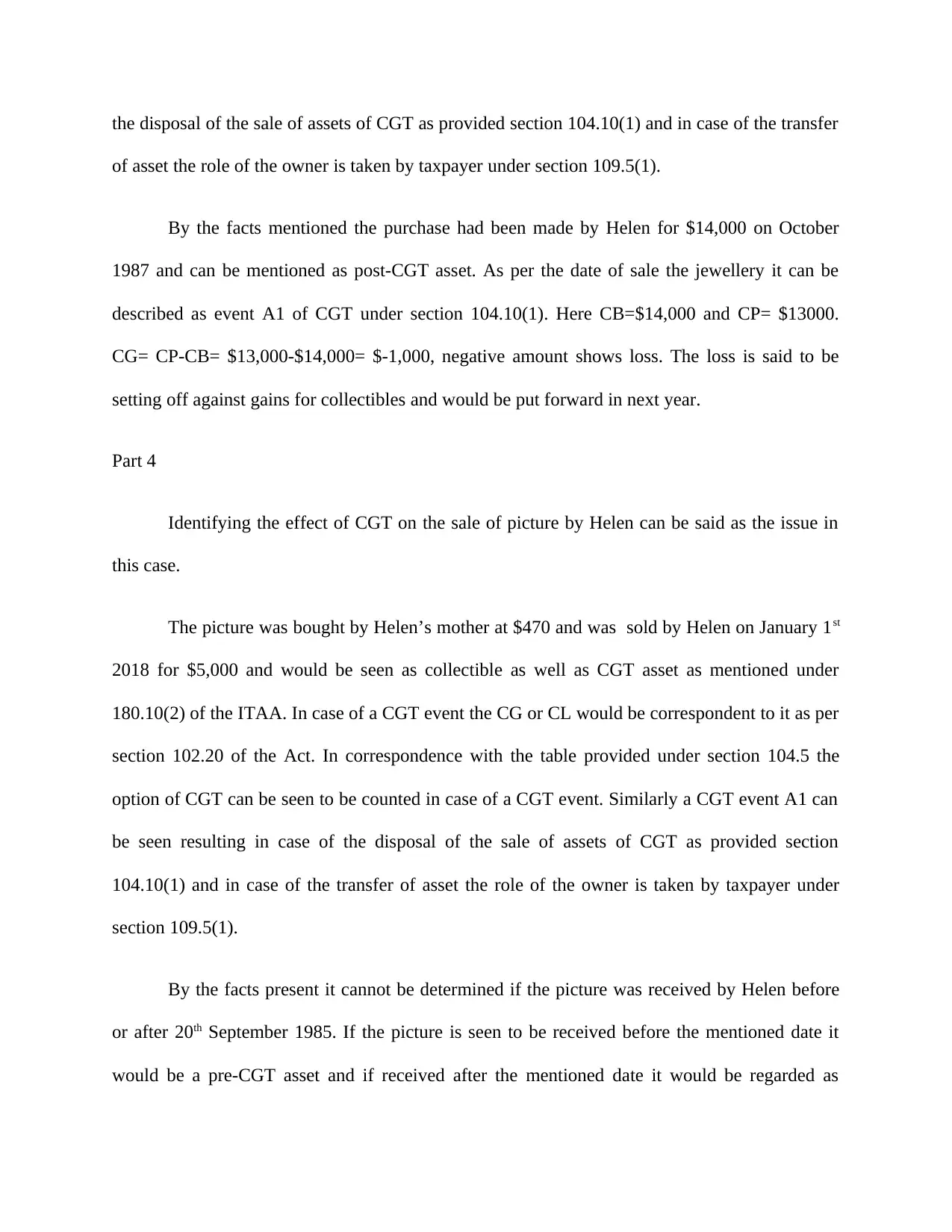
the disposal of the sale of assets of CGT as provided section 104.10(1) and in case of the transfer
of asset the role of the owner is taken by taxpayer under section 109.5(1).
By the facts mentioned the purchase had been made by Helen for $14,000 on October
1987 and can be mentioned as post-CGT asset. As per the date of sale the jewellery it can be
described as event A1 of CGT under section 104.10(1). Here CB=$14,000 and CP= $13000.
CG= CP-CB= $13,000-$14,000= $-1,000, negative amount shows loss. The loss is said to be
setting off against gains for collectibles and would be put forward in next year.
Part 4
Identifying the effect of CGT on the sale of picture by Helen can be said as the issue in
this case.
The picture was bought by Helen’s mother at $470 and was sold by Helen on January 1st
2018 for $5,000 and would be seen as collectible as well as CGT asset as mentioned under
180.10(2) of the ITAA. In case of a CGT event the CG or CL would be correspondent to it as per
section 102.20 of the Act. In correspondence with the table provided under section 104.5 the
option of CGT can be seen to be counted in case of a CGT event. Similarly a CGT event A1 can
be seen resulting in case of the disposal of the sale of assets of CGT as provided section
104.10(1) and in case of the transfer of asset the role of the owner is taken by taxpayer under
section 109.5(1).
By the facts present it cannot be determined if the picture was received by Helen before
or after 20th September 1985. If the picture is seen to be received before the mentioned date it
would be a pre-CGT asset and if received after the mentioned date it would be regarded as
of asset the role of the owner is taken by taxpayer under section 109.5(1).
By the facts mentioned the purchase had been made by Helen for $14,000 on October
1987 and can be mentioned as post-CGT asset. As per the date of sale the jewellery it can be
described as event A1 of CGT under section 104.10(1). Here CB=$14,000 and CP= $13000.
CG= CP-CB= $13,000-$14,000= $-1,000, negative amount shows loss. The loss is said to be
setting off against gains for collectibles and would be put forward in next year.
Part 4
Identifying the effect of CGT on the sale of picture by Helen can be said as the issue in
this case.
The picture was bought by Helen’s mother at $470 and was sold by Helen on January 1st
2018 for $5,000 and would be seen as collectible as well as CGT asset as mentioned under
180.10(2) of the ITAA. In case of a CGT event the CG or CL would be correspondent to it as per
section 102.20 of the Act. In correspondence with the table provided under section 104.5 the
option of CGT can be seen to be counted in case of a CGT event. Similarly a CGT event A1 can
be seen resulting in case of the disposal of the sale of assets of CGT as provided section
104.10(1) and in case of the transfer of asset the role of the owner is taken by taxpayer under
section 109.5(1).
By the facts present it cannot be determined if the picture was received by Helen before
or after 20th September 1985. If the picture is seen to be received before the mentioned date it
would be a pre-CGT asset and if received after the mentioned date it would be regarded as
⊘ This is a preview!⊘
Do you want full access?
Subscribe today to unlock all pages.

Trusted by 1+ million students worldwide
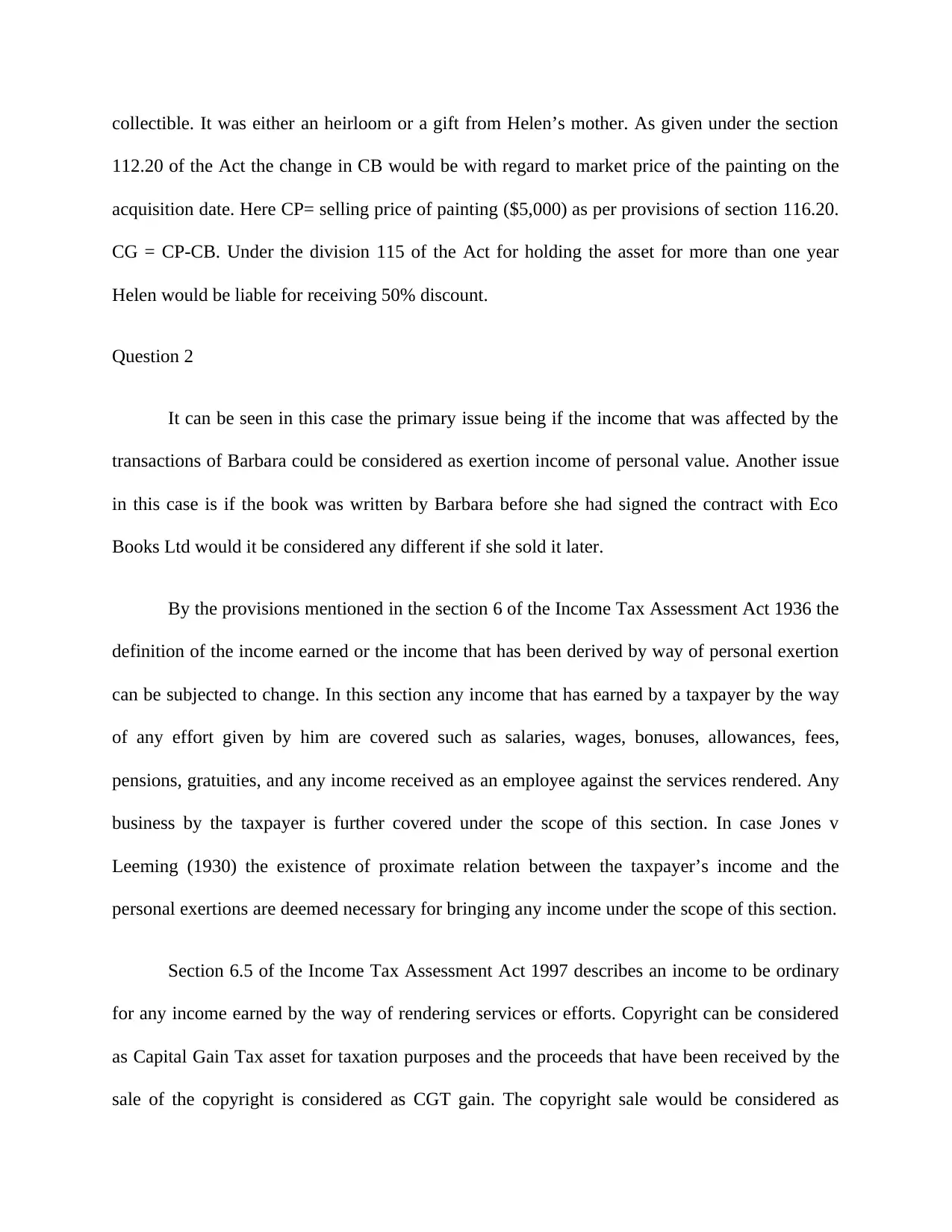
collectible. It was either an heirloom or a gift from Helen’s mother. As given under the section
112.20 of the Act the change in CB would be with regard to market price of the painting on the
acquisition date. Here CP= selling price of painting ($5,000) as per provisions of section 116.20.
CG = CP-CB. Under the division 115 of the Act for holding the asset for more than one year
Helen would be liable for receiving 50% discount.
Question 2
It can be seen in this case the primary issue being if the income that was affected by the
transactions of Barbara could be considered as exertion income of personal value. Another issue
in this case is if the book was written by Barbara before she had signed the contract with Eco
Books Ltd would it be considered any different if she sold it later.
By the provisions mentioned in the section 6 of the Income Tax Assessment Act 1936 the
definition of the income earned or the income that has been derived by way of personal exertion
can be subjected to change. In this section any income that has earned by a taxpayer by the way
of any effort given by him are covered such as salaries, wages, bonuses, allowances, fees,
pensions, gratuities, and any income received as an employee against the services rendered. Any
business by the taxpayer is further covered under the scope of this section. In case Jones v
Leeming (1930) the existence of proximate relation between the taxpayer’s income and the
personal exertions are deemed necessary for bringing any income under the scope of this section.
Section 6.5 of the Income Tax Assessment Act 1997 describes an income to be ordinary
for any income earned by the way of rendering services or efforts. Copyright can be considered
as Capital Gain Tax asset for taxation purposes and the proceeds that have been received by the
sale of the copyright is considered as CGT gain. The copyright sale would be considered as
112.20 of the Act the change in CB would be with regard to market price of the painting on the
acquisition date. Here CP= selling price of painting ($5,000) as per provisions of section 116.20.
CG = CP-CB. Under the division 115 of the Act for holding the asset for more than one year
Helen would be liable for receiving 50% discount.
Question 2
It can be seen in this case the primary issue being if the income that was affected by the
transactions of Barbara could be considered as exertion income of personal value. Another issue
in this case is if the book was written by Barbara before she had signed the contract with Eco
Books Ltd would it be considered any different if she sold it later.
By the provisions mentioned in the section 6 of the Income Tax Assessment Act 1936 the
definition of the income earned or the income that has been derived by way of personal exertion
can be subjected to change. In this section any income that has earned by a taxpayer by the way
of any effort given by him are covered such as salaries, wages, bonuses, allowances, fees,
pensions, gratuities, and any income received as an employee against the services rendered. Any
business by the taxpayer is further covered under the scope of this section. In case Jones v
Leeming (1930) the existence of proximate relation between the taxpayer’s income and the
personal exertions are deemed necessary for bringing any income under the scope of this section.
Section 6.5 of the Income Tax Assessment Act 1997 describes an income to be ordinary
for any income earned by the way of rendering services or efforts. Copyright can be considered
as Capital Gain Tax asset for taxation purposes and the proceeds that have been received by the
sale of the copyright is considered as CGT gain. The copyright sale would be considered as
Paraphrase This Document
Need a fresh take? Get an instant paraphrase of this document with our AI Paraphraser
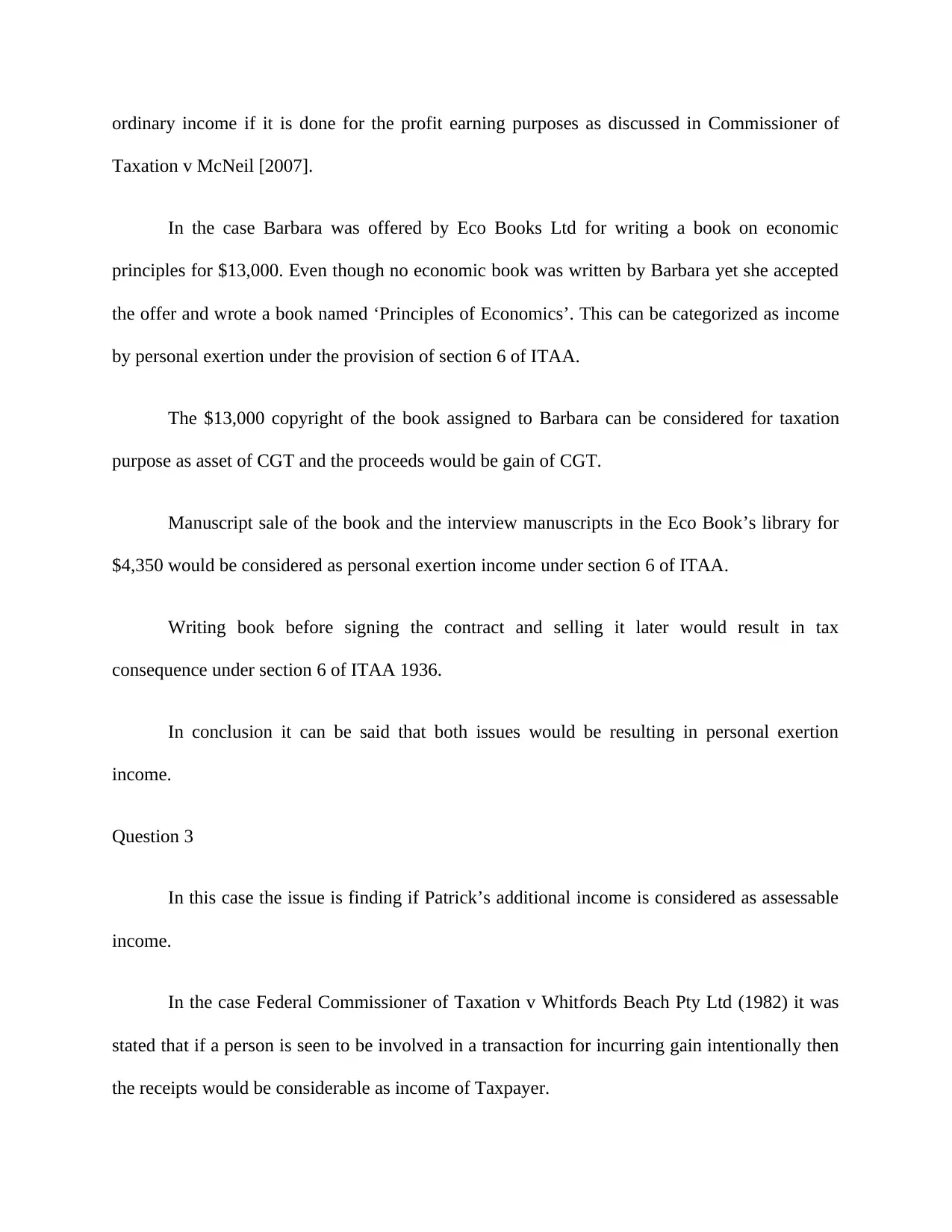
ordinary income if it is done for the profit earning purposes as discussed in Commissioner of
Taxation v McNeil [2007].
In the case Barbara was offered by Eco Books Ltd for writing a book on economic
principles for $13,000. Even though no economic book was written by Barbara yet she accepted
the offer and wrote a book named ‘Principles of Economics’. This can be categorized as income
by personal exertion under the provision of section 6 of ITAA.
The $13,000 copyright of the book assigned to Barbara can be considered for taxation
purpose as asset of CGT and the proceeds would be gain of CGT.
Manuscript sale of the book and the interview manuscripts in the Eco Book’s library for
$4,350 would be considered as personal exertion income under section 6 of ITAA.
Writing book before signing the contract and selling it later would result in tax
consequence under section 6 of ITAA 1936.
In conclusion it can be said that both issues would be resulting in personal exertion
income.
Question 3
In this case the issue is finding if Patrick’s additional income is considered as assessable
income.
In the case Federal Commissioner of Taxation v Whitfords Beach Pty Ltd (1982) it was
stated that if a person is seen to be involved in a transaction for incurring gain intentionally then
the receipts would be considerable as income of Taxpayer.
Taxation v McNeil [2007].
In the case Barbara was offered by Eco Books Ltd for writing a book on economic
principles for $13,000. Even though no economic book was written by Barbara yet she accepted
the offer and wrote a book named ‘Principles of Economics’. This can be categorized as income
by personal exertion under the provision of section 6 of ITAA.
The $13,000 copyright of the book assigned to Barbara can be considered for taxation
purpose as asset of CGT and the proceeds would be gain of CGT.
Manuscript sale of the book and the interview manuscripts in the Eco Book’s library for
$4,350 would be considered as personal exertion income under section 6 of ITAA.
Writing book before signing the contract and selling it later would result in tax
consequence under section 6 of ITAA 1936.
In conclusion it can be said that both issues would be resulting in personal exertion
income.
Question 3
In this case the issue is finding if Patrick’s additional income is considered as assessable
income.
In the case Federal Commissioner of Taxation v Whitfords Beach Pty Ltd (1982) it was
stated that if a person is seen to be involved in a transaction for incurring gain intentionally then
the receipts would be considerable as income of Taxpayer.
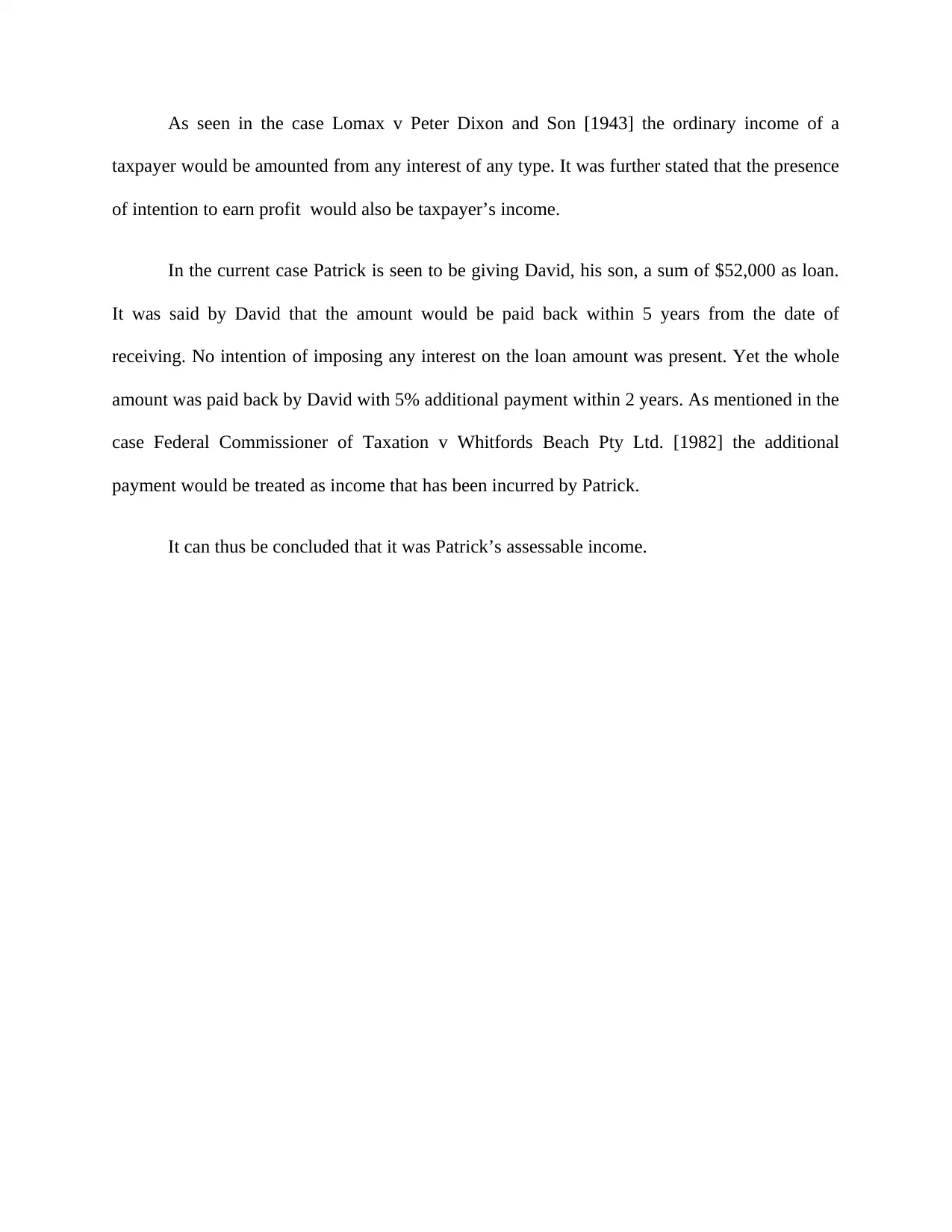
As seen in the case Lomax v Peter Dixon and Son [1943] the ordinary income of a
taxpayer would be amounted from any interest of any type. It was further stated that the presence
of intention to earn profit would also be taxpayer’s income.
In the current case Patrick is seen to be giving David, his son, a sum of $52,000 as loan.
It was said by David that the amount would be paid back within 5 years from the date of
receiving. No intention of imposing any interest on the loan amount was present. Yet the whole
amount was paid back by David with 5% additional payment within 2 years. As mentioned in the
case Federal Commissioner of Taxation v Whitfords Beach Pty Ltd. [1982] the additional
payment would be treated as income that has been incurred by Patrick.
It can thus be concluded that it was Patrick’s assessable income.
taxpayer would be amounted from any interest of any type. It was further stated that the presence
of intention to earn profit would also be taxpayer’s income.
In the current case Patrick is seen to be giving David, his son, a sum of $52,000 as loan.
It was said by David that the amount would be paid back within 5 years from the date of
receiving. No intention of imposing any interest on the loan amount was present. Yet the whole
amount was paid back by David with 5% additional payment within 2 years. As mentioned in the
case Federal Commissioner of Taxation v Whitfords Beach Pty Ltd. [1982] the additional
payment would be treated as income that has been incurred by Patrick.
It can thus be concluded that it was Patrick’s assessable income.
⊘ This is a preview!⊘
Do you want full access?
Subscribe today to unlock all pages.

Trusted by 1+ million students worldwide
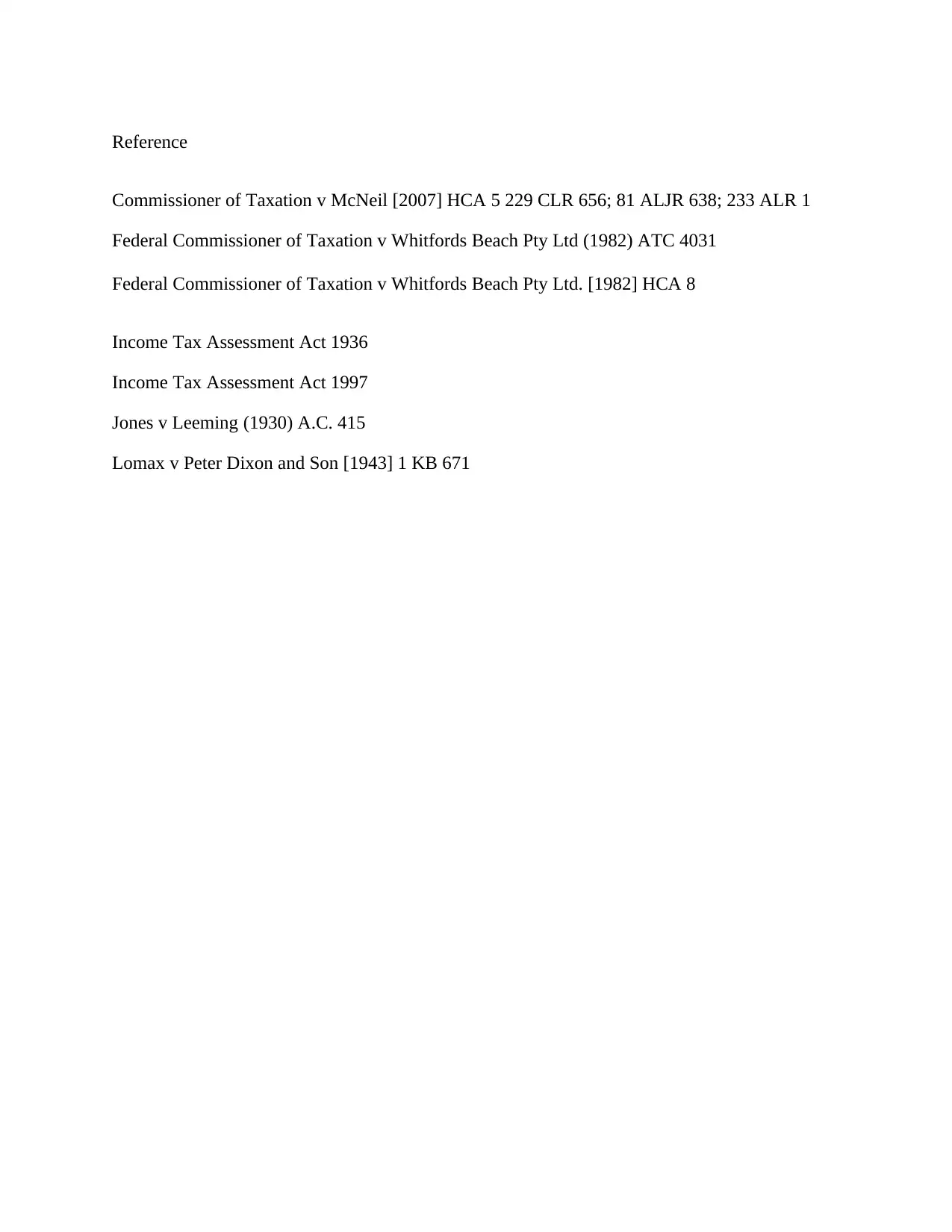
Reference
Commissioner of Taxation v McNeil [2007] HCA 5 229 CLR 656; 81 ALJR 638; 233 ALR 1
Federal Commissioner of Taxation v Whitfords Beach Pty Ltd (1982) ATC 4031
Federal Commissioner of Taxation v Whitfords Beach Pty Ltd. [1982] HCA 8
Income Tax Assessment Act 1936
Income Tax Assessment Act 1997
Jones v Leeming (1930) A.C. 415
Lomax v Peter Dixon and Son [1943] 1 KB 671
Commissioner of Taxation v McNeil [2007] HCA 5 229 CLR 656; 81 ALJR 638; 233 ALR 1
Federal Commissioner of Taxation v Whitfords Beach Pty Ltd (1982) ATC 4031
Federal Commissioner of Taxation v Whitfords Beach Pty Ltd. [1982] HCA 8
Income Tax Assessment Act 1936
Income Tax Assessment Act 1997
Jones v Leeming (1930) A.C. 415
Lomax v Peter Dixon and Son [1943] 1 KB 671
1 out of 7
Related Documents
Your All-in-One AI-Powered Toolkit for Academic Success.
+13062052269
info@desklib.com
Available 24*7 on WhatsApp / Email
![[object Object]](/_next/static/media/star-bottom.7253800d.svg)
Unlock your academic potential
Copyright © 2020–2025 A2Z Services. All Rights Reserved. Developed and managed by ZUCOL.





